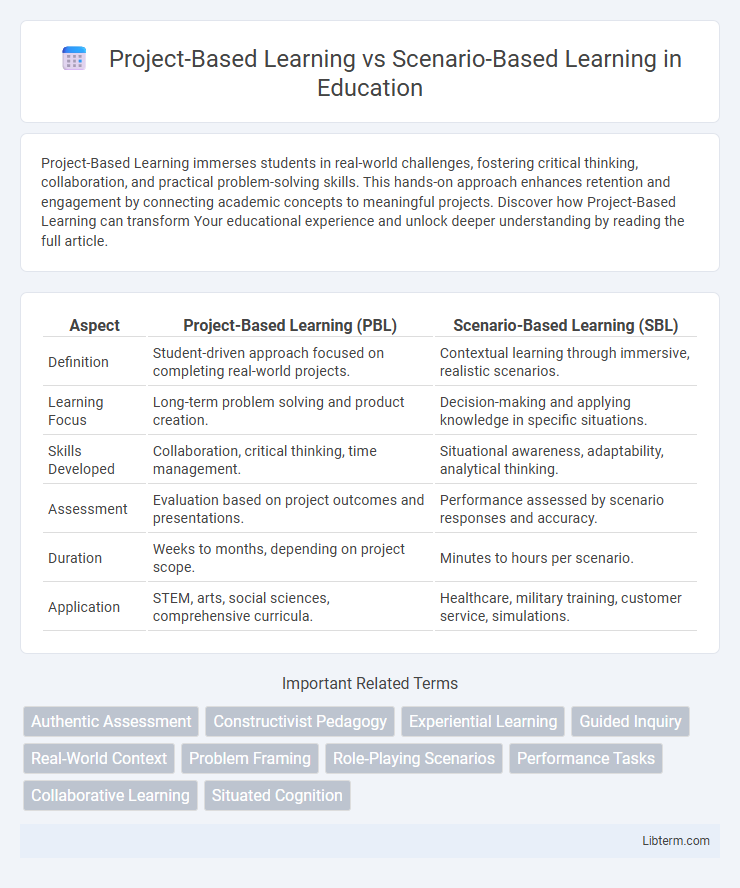Project-Based Learning immerses students in real-world challenges, fostering critical thinking, collaboration, and practical problem-solving skills. This hands-on approach enhances retention and engagement by connecting academic concepts to meaningful projects. Discover how Project-Based Learning can transform Your educational experience and unlock deeper understanding by reading the full article.
Table of Comparison
| Aspect | Project-Based Learning (PBL) | Scenario-Based Learning (SBL) |
|---|---|---|
| Definition | Student-driven approach focused on completing real-world projects. | Contextual learning through immersive, realistic scenarios. |
| Learning Focus | Long-term problem solving and product creation. | Decision-making and applying knowledge in specific situations. |
| Skills Developed | Collaboration, critical thinking, time management. | Situational awareness, adaptability, analytical thinking. |
| Assessment | Evaluation based on project outcomes and presentations. | Performance assessed by scenario responses and accuracy. |
| Duration | Weeks to months, depending on project scope. | Minutes to hours per scenario. |
| Application | STEM, arts, social sciences, comprehensive curricula. | Healthcare, military training, customer service, simulations. |
Introduction to Project-Based and Scenario-Based Learning
Project-Based Learning (PBL) immerses students in complex, real-world projects to develop critical thinking, collaboration, and problem-solving skills through hands-on experiences. Scenario-Based Learning (SBL) uses realistic scenarios to simulate decision-making environments, enhancing learners' ability to apply knowledge in situational contexts and improve adaptive reasoning. Both methodologies emphasize active learning but differ in execution, with PBL centered on producing tangible outcomes and SBL focusing on experiential decision-making processes.
Defining Project-Based Learning (PBL)
Project-Based Learning (PBL) is an instructional approach centered on students actively exploring real-world problems and challenges to acquire deeper knowledge. It emphasizes collaboration, critical thinking, and the creation of tangible products or presentations over an extended period. PBL engages learners by integrating interdisciplinary content and fostering skills such as problem-solving, communication, and self-management within authentic contexts.
Understanding Scenario-Based Learning (SBL)
Scenario-Based Learning (SBL) immerses learners in realistic, context-driven situations that require critical thinking and decision-making, enhancing practical application of knowledge. SBL focuses on simulating real-world challenges, promoting experiential learning through interactive scenarios that adapt to learner responses. This method is effective in developing problem-solving skills and fostering deeper understanding by placing learners in authentic environments where theory meets practice.
Core Principles: PBL vs SBL
Project-Based Learning (PBL) centers on student-driven projects that require applying knowledge to solve real-world problems over an extended period, emphasizing collaboration, creativity, and critical thinking. Scenario-Based Learning (SBL) involves immersive, context-specific situations that simulate real-life challenges, focusing on decision-making, problem-solving, and applying theoretical concepts within a controlled scenario. Both methods prioritize active learning and practical application but differ in scope: PBL delivers a broad, integrated project experience, whereas SBL targets specific skills through focused situational engagement.
Key Differences Between PBL and SBL
Project-Based Learning (PBL) emphasizes completing complex projects over an extended period, fostering skills like collaboration, problem-solving, and real-world application through hands-on tasks. Scenario-Based Learning (SBL) centers on immersive, context-specific simulations or narratives designed to develop decision-making and critical thinking by placing learners in realistic situations. Key differences include PBL's focus on producing tangible outcomes and teamwork, whereas SBL prioritizes situational analysis and adaptive responses within controlled, often shorter, learning environments.
Benefits of Project-Based Learning
Project-Based Learning (PBL) enhances critical thinking and problem-solving skills by engaging students in real-world projects that require collaboration and creativity. It fosters deeper subject comprehension through active exploration and practical application of knowledge. PBL also improves communication skills and boosts student motivation by providing meaningful, student-centered learning experiences.
Advantages of Scenario-Based Learning
Scenario-Based Learning enhances critical thinking and decision-making skills by immersing students in realistic, context-driven challenges that mirror real-world situations. It promotes active engagement and deeper comprehension by requiring learners to analyze scenarios, explore multiple outcomes, and apply theoretical knowledge practically. This method improves retention and transfer of skills across diverse professional fields, making it a highly effective educational approach.
Challenges of Implementing PBL and SBL
Implementing Project-Based Learning (PBL) often faces challenges like resource constraints, time management issues, and the need for extensive teacher training to facilitate student autonomy effectively. Scenario-Based Learning (SBL) implementation hurdles include designing realistic scenarios that align with learning objectives and ensuring learner engagement without oversimplifying complex concepts. Both PBL and SBL require institutional support and continuous assessment to address diverse learner needs and maintain instructional quality.
When to Use PBL or SBL in Education
Project-Based Learning (PBL) is ideal when educators aim to develop students' problem-solving skills through extended, real-world projects that integrate multiple disciplines. Scenario-Based Learning (SBL) fits best for training focused on situational decision-making, allowing learners to practice responses in realistic, controlled environments. Use PBL for fostering creativity and collaboration in complex tasks, while SBL is more effective for mastering specific skills or procedures through contextual scenarios.
Conclusion: Choosing the Right Learning Approach
Selecting between Project-Based Learning (PBL) and Scenario-Based Learning (SBL) depends on educational goals and learner needs. PBL excels in fostering creativity, collaboration, and real-world problem-solving through extended projects, while SBL emphasizes decision-making skills and critical thinking within realistic scenarios. An optimal approach often blends both methodologies to maximize engagement and practical knowledge application.
Project-Based Learning Infographic

 libterm.com
libterm.com